Sanata Dharma University is strategically looking at post-2012 management and operations framework for implementation. Critically, the university is working towards achieving the following key areas, which are also significant for the Conference (JCAP) to engage with:
- Integrating environment to students’ orientation and developing in-campus ecology information board;
- Thematic course formation on the environment for students and professionals;
- In nursery development focusing on biodiversity enrichment;
The university has eight faculties spread among its six campuses:
- Teacher training and education;
- Letters;
- Economics;
- Psychology;
- Science and technology;
- Pharmacy;
- Theology and philosophy; and
- Graduate programs
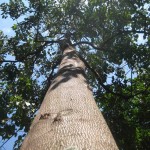 The Center for Environmental Studies, which is one of the support units of the university, was officially established in 2006. The vision is to build harmonious society living comfortably in a sound and sustainable environment. The center seeks to:
The Center for Environmental Studies, which is one of the support units of the university, was officially established in 2006. The vision is to build harmonious society living comfortably in a sound and sustainable environment. The center seeks to:
- build community awareness in the importance of environmental quality;
- promote energy conservation;
- introduce application of technology; and
- address environmental issues.
Strategically, the work seeks for:
- synergy;
- governance;
- business opportunities; and
- collaboration with NGOs, academe and other stakeholders.
In order to contribute in obtaining:
- change, reflected on good policy for environment;
- sustainability programs on environment; and
- significant impact to people i.e. community development and applied technology.
The work goals are achieved through:
- formal course work on environmental studies (biodiversity, ethnobotany, limnology, seashores, physics, etc.);
- research and development;
- applied research for community and local government development;
- SAFE – student action of the environment – program and advocacy work; and
- sponsoring interreligious dialogue with environment and ethnicity as part of the topic.
Hence, the overall activities are guided by four principle of development technology:
- replicable;
- practical;
- comprehensive; and
- affordable.
The Biro Sarama dan Prasaraua (BSP) – Bureau of Facility and Utility is in charge of the overall management of:
- physical facility;
- mechanical and electrical;
- multi-media and support; and
- administration and management.
The BSP’s areas of responsibility and corresponding guidelines, procedures, and responses were presented during the August 2010 visit:
“Greening” the Campus
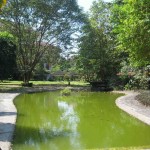 The BSP is implementing a “greening” the campus program through planting:
The BSP is implementing a “greening” the campus program through planting:
- shade-trees;
- aromatherapy plants;
- dust filter plants; and
- mosquito repellent plants.A pond is also set up at campus III along with an effort to have a mini “forest” inside the campus, which eventually improve local climate in the campus. The water for the pond is pumped from underground, which need measurements in terms of rate and volume extracted.
Currently, kemiri Aleurites mollucana is planted in the “forest” plantation. Soils can be loosen up in order to have better infiltration. A selection cutting can be made in order to have space for indigenous species i.e. meranti, damar, agoo. There could a three layered-canopy, which could also enhance water infiltration in the area.
A nursery is established in campus and in an effort to diversify the nursery may focus indigenous species as it now has accomplished good composting. This effort is also in response to the broader international program of REDD+.
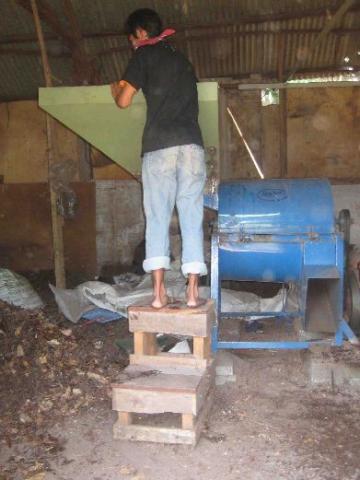 Composting and Waste Management
Composting and Waste Management
The university is efficiently sorting their wastes. Papers are already sorted within each office or faculty and there are various bins for segregation.
Dried leaves are collected and using a mechanical cutter prepared for compost. The compost is a mixture of dried leaves (3 sacks) goat’s dung (1 sack), and reagent.
Illustrating the processes would facilitate deeper involvement of students to waste and other environmental related management projects or programs of the university.
Drainage
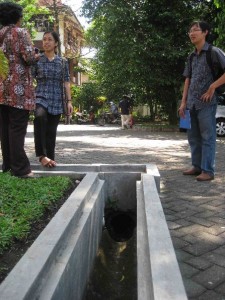 Drainage systems are well designed and set up having the appropriate angle for effective flow of water. All drainage networks are connected to the infiltration wells, for return of storm water from the building to the ground water. Other initiatives are using paving blocks and grassblock for pavement, and using gravel as ground cover.
Drainage systems are well designed and set up having the appropriate angle for effective flow of water. All drainage networks are connected to the infiltration wells, for return of storm water from the building to the ground water. Other initiatives are using paving blocks and grassblock for pavement, and using gravel as ground cover.
Water Harvesting, Treatment and Recycling
Generally, water in all campuses is pumped from the watertable. A water tank or reservoir is available in each campus to store pumped-water. The groundwater extraction rate needs to be measured in order to provide baseline data for impact on watertable and mapping possible groundwater subsidence or risk. Water at Paingan campus (campus III) is treated as it contains high Pb and Fe. This process entails sophisticated procedure, which is significant to document.
Wastewater from hand basins is directly connected to the infiltration well for recycling while septic tanks follow a separate system. Water form the septic tank is used for spraying over the football field, every three months. Measuring effectively the percentage use of wastewater is important so that the technology and system is maximised. The excess from the water waste tank could be applied to other areas other than the football field.
In constructing buildings, wind direction and orientation to the sun are considered so that energy could be efficiently conserved. Appropriate ventilation and lightning are used in each building. The electricity is distributed from the powerhouse to the each building. Each building then has a power circuit station that regulates power supply and short-circuits. Strict regulation on installing air conditioning is implemented.
Support Units
Other units such as the Campus Ministry is also implementing special program on the environment. The ministry accompany the students and develop programs on Earth Day. This effort seeks to build awareness amongst students and eventually deepened their understanding of the environment. Students are already aware of the global warming through media hence, the ministry wants to developed activities that would make the students involved. The challenge is to scale up the action – from tree planting to more sustainable activity and lifestyle change.
Creatively, the ministry seeks to tap music, drama, and arts to promote students’ awareness to environment. Also, some students are sent through exchange program (CAM) of the catholic universities in Asia and discuss about the environment. The discussion from CAM is then re-echoed to other students in the university.
2012 and Beyond
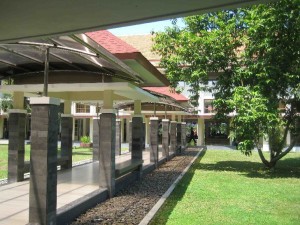 The institutional strategic planning for 2012 – 2017 is a good opportunity to integrate ecological strategies to different programs and initiatives of the university. Critically, the university seeks to set up the guidelines and criteria in developing an ecological or “green” campus not only focused on institutional management and operations but also to students and staff programs:
The institutional strategic planning for 2012 – 2017 is a good opportunity to integrate ecological strategies to different programs and initiatives of the university. Critically, the university seeks to set up the guidelines and criteria in developing an ecological or “green” campus not only focused on institutional management and operations but also to students and staff programs:
- continuing programs that sustains students’ and institutional ecological initiatives;
- incorporating an environmental way of proceedings;
- refining selection of tree species;
- strengthening off-campus relations through environmental exchange programs and formative courses;
- establishing eco-terrestial biodiversity, identifying measurement of sustainable agriculture (beyond profit and production criteria);
- developing a sustainability monitoring and accounting, and
- deepening of spirituality of reconciliation through engagements.


